

Children & Families Civil & Criminal Justice Education Elections Employment & Labor Energy Environment Financial Services Fisca1 Health Transportation.
Children & Families | Civil & Criminal Justice | Education | Elections | Employment & Labor | Energy | Environment | Financial Services | Fiscal | Health | Transportation

Housing and child care, two essential ingredients for thriving families and communities, have been hot topics in recent years and continue to get hotter. Adoption, on the other hand, was a sleeper issue until it broke through following the Supreme Court’s Dobbs decision.
Read More
As the nation navigates the lingering challenges of the pandemic, new public safety concerns have emerged, among them fentanyl overdoses, car jackings, catalytic converter thefts and other crimes of opportunity. Legislatures are responding with tailored criminal and juvenile justice policies and a focus on community-based strategies to reduce violence.
Read More
Some policymakers argue that our nearly century-old education system no longer meets our needs and is not adaptable enough in times of disruption or crisis. Addressing that challenge, beginning in 2023, won’t be easy; legislators face a sticky system averse to change.
Read More
The pandemic brought with it numerous election policy changes, many of them temporary. Lawmakers are likely to keep their sights on paying for elections, defining the duties of election officials, maintaining voter rolls and ensuring accurate vote counts.
Read More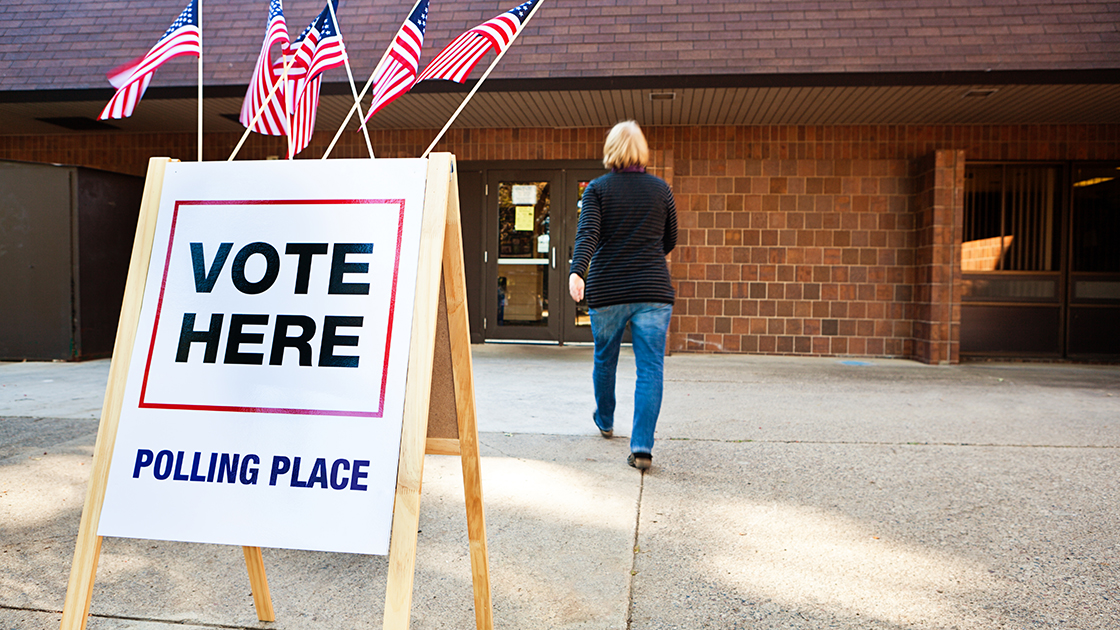
The U.S. labor market has more job openings than workers seeking employment. But lawmakers aim to attract and retain workers by offering hiring incentives, better benefits and skills training.
Read More
Using major federal investments, states will be upgrading the electric grid, expanding the electric vehicle charging infrastructure and managing the economic impacts of the transition away from fossil fuels.
Read More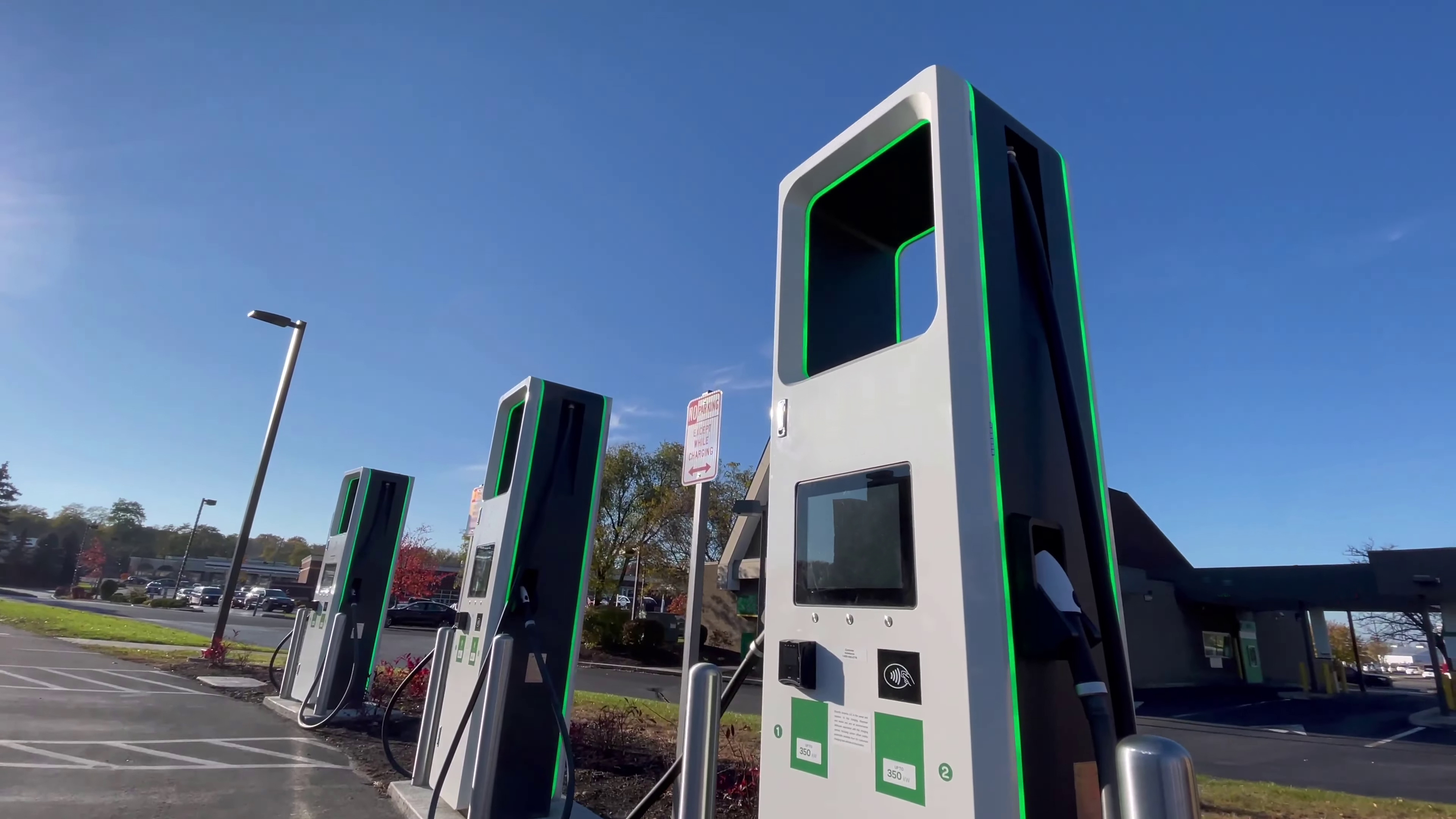
With damaging weather events becoming more frequent, lawmakers will be using federal aid to protect communities and speed post-disaster recovery. Also on their list: improving water infrastructure and limiting the health threats posed by PFAS chemicals.
Read More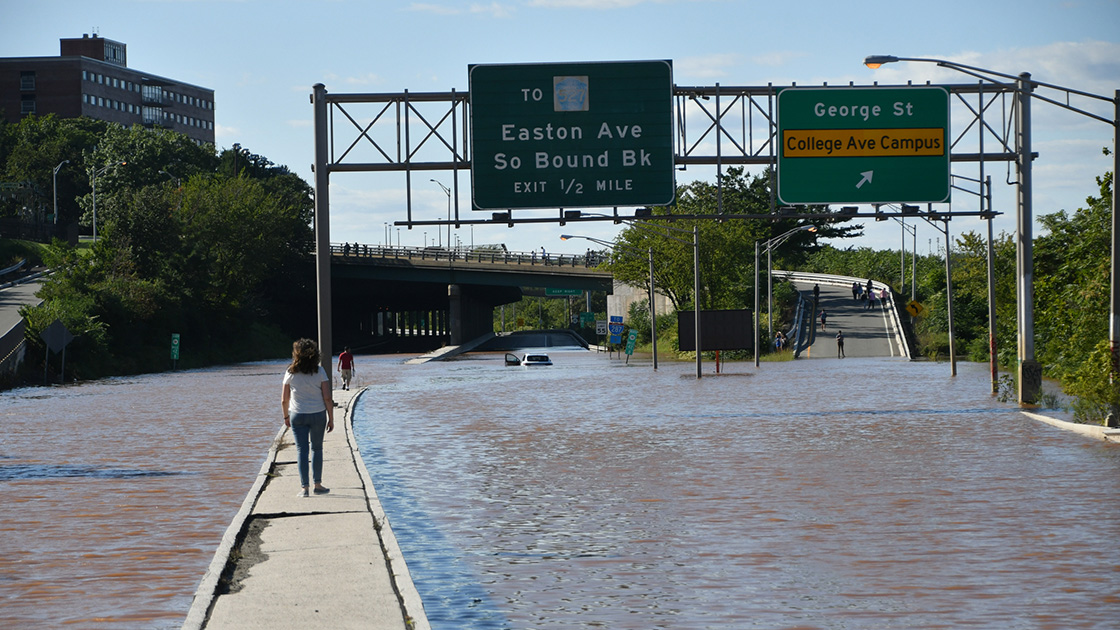
As the internet pervades nearly every aspect of consumer life, state and federal lawmakers are addressing the growing interest in using digital currencies, the need for data privacy, and a fundamental reality: Broadband is not equally available to all Americans.
Read More
State fiscal situations continue to rebound as the COVID-19-induced recession subsides, though lingering inflation adds uncertainty. Despite that and other factors, including the war in Ukraine, states are hopeful the good times will continue, even as they prepare for slowing growth and potential challenges ahead.
Read More
State legislatures are taking steps to address pandemic-induced workforce shortages and rising rates of overdoses, mental health disorders and maternal mortality.
Read More
As vehicle fuel-efficiency rises and more people drive EVs, lawmakers face a tough task: making up for the revenue once generated by gas taxes. Some states are turning to road usage charges. Meanwhile, federal funds are boosting new and existing road, transit and traffic safety programs.
Read More

Income-qualified homes in Denver’s Central Park neighborhood. No state is immune as the affordable housing crisis works its way up the income ladder.
NCSL Staff Report | Dec. 5, 2022
Close articleHousing and child care, two essential ingredients for thriving families and communities, have been hot topics in recent years and continue to get hotter. Adoption, on the other hand, was a sleeper issue until it broke through following the U.S. Supreme Court’s decision in Dobbs v. Jackson Women’s Health Organization. Now more legislators are reconsidering adoption laws in their states.
Which of these issues will gain traction in your state in 2023?
Until recently, the supply and affordability of housing was largely in the hands of city and county officials. Now a growing number of state legislators are seeking solutions for the extreme lack of safe, stable, affordable housing in urban, suburban and rural communities. No state or region is immune as the crisis works its way up the income ladder.
No state has an adequate supply of housing for its lowest-income renters. The hourly income needed to rent a modest home varies by state, from below $17 to $40. While many states have increased their minimum wages, nowhere has it been enough to keep up with the cost of housing. The pandemic as made matters worse, with rents increasing by an average of 18% over the last five years. Often due to a lack of affordable rental homes, an estimated 3.7 million people live in doubled-up households.
The lack of rental affordability impacts household economic security and can lead to homelessness. Homelessness was increasing before the pandemic, then slowed temporarily due to eviction moratoriums, which have mostly ended. According to the Department of Housing and Urban Development, on a single night in 2021, more than 326,000 people experienced sheltered homelessness, 131,377 people experienced sheltered homelessness as part of a family, and 15,763 people under age 25 experienced sheltered homelessness as unaccompanied youths. These figures do not include unsheltered people, who have not been counted by HUD since 2019 due to the pandemic.
The dream of owning a home is out of reach for a growing swath of U.S. families. Nonetheless, cultivating homeownership is one way to reduce displacement, strengthen credit, promote asset-building and improve economic mobility. Recent data shows a 20.6% year-over-year increase in home values, with more metro areas facing rising prices than at any time in the last 20 years. Multiple factors have contributed to soaring housing prices, including supply and construction costs, interest rates and generational shifts in homeownership.
To address these issues, states are considering legislation to encourage mixed-use and transit-oriented development, zoning changes, and mortgage and financing assistance. Legislators are exploring ways to increase the housing supply via state housing trust funds, the role of housing authorities in mitigating the crisis and the use of housing assistance programs to promote stability. Additionally, some states are turning to manufactured homes to increase the supply of affordable units. ARPA funds are available to support many of these strategies.
Numerous interrelated factors contribute to the housing crisis, making solutions difficult to find. But states have levers to support housing stability and affordability and can collaborate with localities to identify issues and solutions.
NCSL contacts: Heather Wilson, Heather Hanna
While much of the labor market has rebounded from pandemic-related losses, one critical sector lags behind: child care. With nearly 90,000 fewer child care professionals in the field today than in early 2020, millions of working parents and employers are feeling the squeeze. Despite lengthy waitlists, many early learning classrooms sit empty due to a shortage of child care professionals. Rural communities, low-income families, families with infants and toddlers, and parents who work outside the typical 9-to-5 schedule face the biggest challenges in accessing child care.
The issues that threaten the stability and affordability of child care predate the pandemic. Extremely low wages, limited access to benefits and stressful working conditions for decades have contributed to high turnover in the workforce. Child care business owners, many of whom are self-employed women working out of their homes, have long struggled to cover the costs of doing business and pay themselves an adequate wage. And at an average annual price of over $10,000 for one child’s care, many parents find themselves priced out of licensed care altogether.
To address these issues, some states have ramped up their efforts to strengthen the workforce and help parents afford care. With the help of federal COVID relief funds, states are supporting child care professionals through retention bonuses and stipends; start-up funds and training for new child care business owners; expedited credentialing opportunities; coverage of health insurance costs; and more. Policymakers are also identifying ways to help more middle- and low-income families afford care and to incentivize employers to support child care access for employees.
States have a long way to go to put child care on stable footing. Identifying policy solutions to support child care professionals—sometimes referred to as the “workforce behind the workforce”—will be vital to ensuring economic stability for families, employers and states.
NCSL contacts: Jeni Palmer, Heather Hanna
The 2023 legislative session will likely bring a substantial uptick in adoption-related legislation. NCSL predicts the increase will focus on three main areas:
Since the U.S. Supreme Court’s decision in Dobbs v. Jackson Women’s Health Organization, NCSL has received a noticeable increase in research requests from members regarding adoption. Support for adoptive parents is on legislators’ radar in many states. Adoption assistance, such as education services and peer-support networks, can help prepare families for successful adoptions. In certain cases, adoptive parents can also receive financial assistance under Title IV-E of the Social Security Act. Additionally, some states provide financial assistance to encourage kinship guardianship when reunification with a child’s parent is not possible. Besides adoption assistance, some legislators are looking into adoption rights, “adoption-friendly” qualifications and policies to expedite the adoption process.
Between January and August 2022, legislatures in 21 states and one territory enacted 37 adoption-related bills. Nine bills involved updates to adoption procedures for either public or private adoptions. Seven bills addressed access to adoption records or original birth certificates. Seven bills related to supports or benefits, such as paid leave following the adoption of a child or tax credits for adoption-related expenses. The remaining legislation addressed adoption requirements, the reduction of discrimination, the legal rights of adoptees and minor language changes to existing statutes.
NCSL contact: Jill Yordy

Deflection pathways help connect people with mental health needs to community-based services as an alternative to making arrests.
NCSL Staff Report | Dec. 5, 2022
As the nation navigates the lingering challenges of the pandemic, new public safety concerns have emerged, among them fentanyl overdoses, carjackings, catalytic converter thefts and other crimes of opportunity.
Legislatures are responding by tailoring criminal and juvenile justice policies and focusing resources on community-oriented approaches that can reduce violence and prevent people from becoming more deeply involved with the justice system.
At the front end of the justice system, legislatures are expanding community-based crisis services and responses that don’t involve law enforcement, including deflection programs and access to treatment. Deflection pathways help connect individuals who have substance use or mental health needs to community-based treatment and services as an alternative to making arrests or taking no action.
For people released from prisons and jails, a lack of housing, employment and other support systems can increase the likelihood of continued involvement in the justice system. Legislatures are supporting returning citizens by addressing the impacts of fines and fees, providing identification after release and making changes to criminal record policies. In Wisconsin, lawmakers convened a committee to study efforts to increase employment opportunities and improve post-release connections for people while they are still incarcerated. These supportive policies can be an important part of public safety; research has shown that successful reentry leads to reduced recidivism.
In recent years, many states have reduced the penalties associated with simple drug possession, focusing higher penalties and resources on people who are trafficking or dealing large quantities of drugs. While this trend continues, some states are reevaluating reduced penalties for fentanyl, which can be deadly even in small amounts. Colorado passed legislation in 2022 making it a drug felony to possess more than 1 gram of fentanyl. In the same bill, the state created programs for fentanyl use prevention, education and treatment, emphasizing the need to provide supports for people with substance use disorders.
In the last couple of years, most states have considered legislation addressing the recent increase in catalytic converter thefts. Twelve states enacted bills in 2021, and at least 20 states enacted 25 bills this year; the trend is likely to continue in 2023. Most enacted legislation added requirements for the sale and purchase of unattached catalytic converters. Minnesota allocated funds to establish a pilot program that permanently marks the devices with a unique identification number, which is then registered with law enforcement.
Legislatures are requiring uniform data collection and reporting by local agencies to understand who is in the system and how they move through it. Data is also vital for lawmakers when making policy decisions and allocating state resources.
To create safer communities, several initiatives have emerged from the Justice Department and the White House. The DOJ’s Bureau of Justice Assistance released its Community-Based Violence Intervention and Prevention Initiative, which aims to increase the use of evidence-informed and community-tailored strategies to reduce violence. The initiative includes a checklist to guide local governments in creating multidisciplinary violence intervention policies and programs, and in collecting data to assess the effectiveness of programs after implementation.
An executive order, signed by President Joe Biden in May 2022, focuses on increasing public trust through policing reforms for federal law enforcement officers. It also incentivizes state and local agencies with funds to adopt similar policies, including revising use-of-force standards, limiting agencies’ ability to use military equipment, and limiting no-knock warrants and those that permit unannounced forcible entry.
Congress passed the Bipartisan Safer Communities Act, which made many changes to federal firearms laws and provided billions of dollars for mental health and community-based violence intervention programs. Notably, one new provision prevents people convicted of domestic abuse from owning a firearm regardless of marital status and partially closes the “boyfriend loophole”; both moves are designed to protect dating partners from gun violence.
For more information, contact Sarah Brown, director of NCSL’s Criminal Justice Program.
Close article
Researchers continue to assess the effects of extended remote learning on younger students.
By Michelle Exstrom | Dec. 5, 2022
Education systems across the states have suffered disruptions of historic proportions over the past three years, and educators, students and families are feeling the effects. Schools and universities are open again and trying to return to normal, but nothing is the same. Many teachers and principals have left their positions, and some students still have not returned to their schools or campuses. Unfortunately, the data shows students were profoundly affected, with test scores revealing just how far behind they’ve fallen. This has been especially true for students of color and those with disabilities, exacerbating inequities that have persisted for decades.
Addressing these challenges will require rethinking the education system, according to the legislators and staff in NCSL’s International Education Study Group who have spent the last seven years studying the world’s most effective education systems. They argue that our nearly century-old system no longer meets our needs and is not adaptable enough in times of disruption or crisis. The work, beginning in 2023, won’t be easy; legislators face a sticky system averse to change.
Legislators remain concerned about students being far behind in their learning and the impact of that on their mental health. Assessments of all kinds—short-cycle, annual, nationwide—show that student learning, especially that of the youngest learners, is lagging because of the pandemic. NWEA and Curriculum Associates, both of which administer millions of reading and math tests to students throughout the school year, have released data showing that nearly all students, from preschoolers to young adults, were impacted and that those who traditionally struggle the most have fallen even farther behind. The National Assessment of Educational Progress released scores in October this year showing that the declines in math and reading and the gaps between high- and low-performing students all had reached historic levels.
With federal ESSER funds at their disposal, school districts have deployed many intervention strategies, including high-dose tutoring, updated curriculum and technology, more teachers, summer and afterschool programs, and counselors for students and teachers who are struggling. Legislators will be watching how those funds are spent, whether the strategies are effective, and how state policy can continue to support these efforts to get students back on track.
In 2023, legislators will continue to focus on the challenge of recruiting and retaining educators, meaning this is likely to be a highly legislated topic. While nearly every district across the country is reporting workforce shortages, the solution for each school, district and state might be different. Legislators will likely hold hearings and meet with state and local policymakers, parents, and school leaders and teachers to identify promising solutions.
In 2022, legislators in many states investigated their own shortages and which state policies might address this challenge. They know this isn’t a new challenge, but what’s new or different now? They are discovering—and surveys back this up—that the answers include a combination of low pay, lack of respect from parents and the community, lack of high-quality curriculum and technology, outdated buildings, concerns about personal safety, student emotional and academic challenges, poor school leadership and disgruntled colleagues. Teachers are reporting significant stress and mental health challenges as a result. The challenges in teaching have been around for a long while but have worsened since the pandemic.
Some areas are seeing severe teacher shortages, particularly in traditionally hard-to-staff subjects. Legislators also are concerned about the state of teaching and the adults in the system. They are well aware of the research showing that teachers and principals are the most influential school factor in student outcomes. And only effective school principals can inspire and support the best teachers and create optimum learning conditions, which are sorely needed right now.
Unfortunately, data from a 2022 RAND survey of teachers and principals shows that they are struggling. Preparation programs have seen a decline in teacher candidates, fewer teachers are applying for open positions, and many teachers have opted to leave or retire. The same is happening with school principals. Support staff, including education assistants, counselors, cafeteria staff and bus drivers, all are in very short supply, too. This has left schools sparsely staffed at a time when students need highly effective teams of experts focused on their recovery, crippling the system’s ability to respond.
Legislators have been concerned about student debt for some time, and recent federal actions have spurred those looking for ways to lower the cost of credentials, including traditional higher education.
The cost of these opportunities has climbed to record levels over the last decade, bringing new levels of student borrowing and defaults. In 2019, total student loan debt held by U.S. borrowers climbed to over $1.7 trillion. More than 44 million Americans owe a balance on a student loan, with the average borrower owing more than $25,000. Federal plans to relieve current debt are uncertain, so states will surely be looking into strategies not only to assist current debtors through oversight, forgiveness or tax relief, but also to make postsecondary degrees and credentials more affordable in the first place and help students complete their credentials.
Michelle Exstrom directs NCSL’s Education Program.
NCSL’s International Education Study Group will release new policy recommendations for legislators and staff on Dec. 5.
Close article
The pandemic brought about an unprecedented number of election policy changes, which led to a record number of election-related bills in 2021 and ’22.
NCSL Staff Report | Dec. 5, 2022
As COVID-19 went from zero to 60 and life came to a near standstill in 2020, election officials were faced with a slew of policy changes—many temporary—coming from legislatures, governors and chief election officials. In a field where incremental change is the norm, these overnight decrees about how to manage voting at polling places and by mail were, to understate it, a challenge. A predictable response to that year’s many changes was a record number of election-related bill introductions in 2021 and ’22. (Worth noting: The number of enactments remained on par with previous years.)
What about 2023? The ideas below may be coming to a hearing room near you.
In 2020, an infusion of philanthropic funding provided directly to local election offices rather than to state officials helped ensure that the sudden demand for absentee ballots and all the paper accoutrement associated with them (outer envelopes, inner envelopes, instructions, etc.) could be paid for and that adequate supplies of personal protective equipment were on hand. In the last two years, 21 states made it clear that elections, the foundation of our representative democracy, are a public service that must be paid for with public dollars. That raises the question, of course, of who should pay for elections? In 2023, expect to see lawmakers grappling with election financing. Ballots include local, state and federal races, but mostly, it is local jurisdictions that fund elections. Do states want to follow the money and perhaps split the tab? Would states welcome more federal financial support? Is funding adequate as is?
While professional election officials were lauded in the aggregate for managing a presidential election during a pandemic, that election also shined a light on who, exactly, plays a role in elections. A handful of states enacted laws in 2021 codifying what happens if an election official doesn’t follow state law; this year, a different handful enacted laws adding protections for local election officials who face doxing, trolling, harassment or threats on social media or in person. In 2023, expect more of the same—and perhaps tuneups to laws regulating what poll watchers can see and do. These may be the typical partisan poll watchers who have been part of the election ecosystem for over 100 years, or they may be the less common nonpartisan election observers who aim to provide feedback for continuous improvement. Think academics and international observers.
Forever and a day, job one in the elections world has been identifying who can vote; that’s why voter registration was developed over 100 years ago. In the 2010s, state legislatures—tasked in Article 1, Section 4 of the U.S. Constitution with prescribing the “Times, Places and Manner of holding Elections for Senators and Representatives”—focused mostly on registration and voter ID. The legislative options are many: online voter registration, same-day registration, automated registration, voter ID requirements and exemptions, voter verification for absentee voting and more. Nationwide, one word covers all these policies: more. The number of states with each of these policies just keeps climbing. For 2023, expect still more. More bills on the use of technology to improve voter registration. More bills on maintaining voter rolls since voters rarely tell their local officials when they move away. More bills to permit data sharing within states for jury lists and prison records and with federal or intrastate data sources. And more bills fine-tuning voter ID requirements and exemptions.
The holy grail of election administration is to count each vote accurately and only once while preventing ineligible votes from being cast. Old-school approaches to accuracy include lots of list-making, process-tracking and double-checking. In recent years, states have deployed technology to ensure accuracy. GIS can assign every voter to the right precinct and district more accurately than list-based systems. Improving voter-facing communications from election officials means voters don’t have to rely on the sometimes imprecise information coming from their Instagram feeds. Revisiting state certification standards for voting equipment and making it a crime to tamper with election equipment add safeguards. Investing in cybersecurity reduces the risk of interference. And considering statutorily defined post-election audits may quell worries.
Close article
Sixteen states have created retirement programs for workers who lack access to on-the-job savings opportunities.
NCSL Staff Report | Dec. 5, 2022
The paradox of the U.S. labor market is that there are more job openings than workers seeking employment. The working-age population is sufficient to fill current job openings, but labor force participation has yet to return to pre-pandemic levels. The pandemic accelerated many retirements and reassessments, and it emboldened workers to request higher pay, greater benefits and more flexibility and training. Employees who remained on the job have experienced burnout and exhaustion as they cover the work created by unfilled vacancies, further exacerbating retention problems. Because these market conditions are likely to persist for a few more years, states are considering several policy options in response.
In August 2022, 18 states saw unemployment rates fall below 3%, meeting or beating previous records. While low unemployment may be good news for employees, it places upward pressure on wages and has led to an unprecedented number of workers quitting to seek new jobs.
States are looking to grow their labor forces by engaging with working-age adults who are not currently employed. They’re focusing recruitment efforts on historically underrepresented populations, including people with disabilities, women of color and formerly incarcerated individuals. States also are recruiting beyond their borders. For example, Vermont and West Virginia are offering financial incentives to people who move to their states to work. Other states have considered relaxing or eliminating residency requirements.
States including California, Colorado and Washington are embracing wage transparency policies that require job postings to include salary ranges. Other states implemented laws requiring employers to disclose salary ranges by default or upon request during the candidate interview process. These policies typically aim to reduce pay discrepancies among different demographics, but they could also boost applicant interest.
Driven by stagnant wages and burnout, the public sector has been hit especially hard by increased turnover. Excluding higher education employees, state government payrolls are at one of their lowest points since 1993. Lawmakers across the country are raising state employee compensation and expanding workplace mental health supports to relieve burnout and fatigue. Policymakers are sure to continue exploring recruitment and retention efforts into 2023 to boost state economic growth.
The tight labor market has emboldened workers of all types, including independent contractors and gig workers, to seek improved benefits or positions that can meet their needs.
A growing number of states are considering the costs of workers reaching retirement age with insufficient savings. Recent research found these savings deficits will result in increased public assistance costs, reduced tax revenue, decreased household spending and lower employment over time. Almost half of private sector employees ages 18 to 64 (57 million Americans) do not have the option to save for retirement at work. Sixteen states have now enacted legislation creating retirement programs for private sector workers who lack access to on-the-job savings opportunities. Hawaii and Delaware adopted such programs in 2022, and Arkansas launched a study of related issues. Existing state programs boast over $500 million in assets, which are concentrated in three of the earliest adopters: OregonSaves, CalSavers and Illinois Secure Choice. Several other programs, including those in Colorado and Virginia, are slated to launch in 2023.
At the height of the pandemic, millions of people found themselves struggling to work while caring for themselves or a sick family member. As a result, many workers are seeking paid leave benefits from employers. Currently 11 states and the District of Columbia require paid family leave, and 16 states and D.C. require paid sick leave. Maryland and Delaware both adopted paid family and medical leave programs in 2022, and California extended increased wage replacement rates for its disability insurance and paid family leave program. Continuing a trend, South Carolina joined New Hampshire and Georgia in offering paid parental leave for state employees.
States are considering benefits that could help the growing gig and independent workforce. By some estimates, more than a quarter of U.S. workers participate in nontraditional work arrangements, leaving them without easy access to many traditional benefits. State and federal policymakers are contemplating how a suite of portable benefits linked to employees rather than employers might bridge this gap. Since 2018, lawmakers in at least a dozen states have introduced legislation that would create portable benefit programs for gig workers, allocate funds to foster experimentation in this area or study related issues. Worker classification issues are tightly bound up with portable benefits policy debates throughout the states. The coming year is sure to see lawmakers continue to grapple with the promise and disruption of the on-demand economy, and debate the ways labor market dynamics might influence nontraditional worker benefits.
The surge of job losses and unemployment claims during the pandemic brought public attention to the quality of many states’ workforce programs and their infrastructure. Delayed benefits and improper payments have led to renewed interest in modernizing unemployment systems. Antiquated hardware is being replaced and outdated programs revamped. Now that Department of Labor “tiger teams” have begun reporting the outcomes of their assessments and providing recommendations to states, the focus is turning toward installing new, modern systems to verify identities, prevent fraud and build resilience into unemployment systems.
Workers seeking new career paths or new skills have been turning to state workforce agencies for the training and employer connections they need. The federal government is helping, too. Recently, the Labor Department announced $199 million in grants to help dislocated and underserved workers enter, return to or advance in the workforce.
In addition, the department and state legislatures are focusing on apprenticeships as a form of job training. Most apprenticeship programs teach students the tools of a trade and provide hands-on education with partner employers. Apprenticeships historically trained workers for trades such as plumbing, carpentry and construction, but there is increasing movement to include nontraditional fields. Some states now sponsor programs in areas such as cybersecurity, nursing and information technology. The Labor Department is also promoting apprenticeship programs for teachers to address shortages in education.
For more information, contact Suzanne Hultin, director of NCSL’s Employment, Labor and Retirement Program.
Close article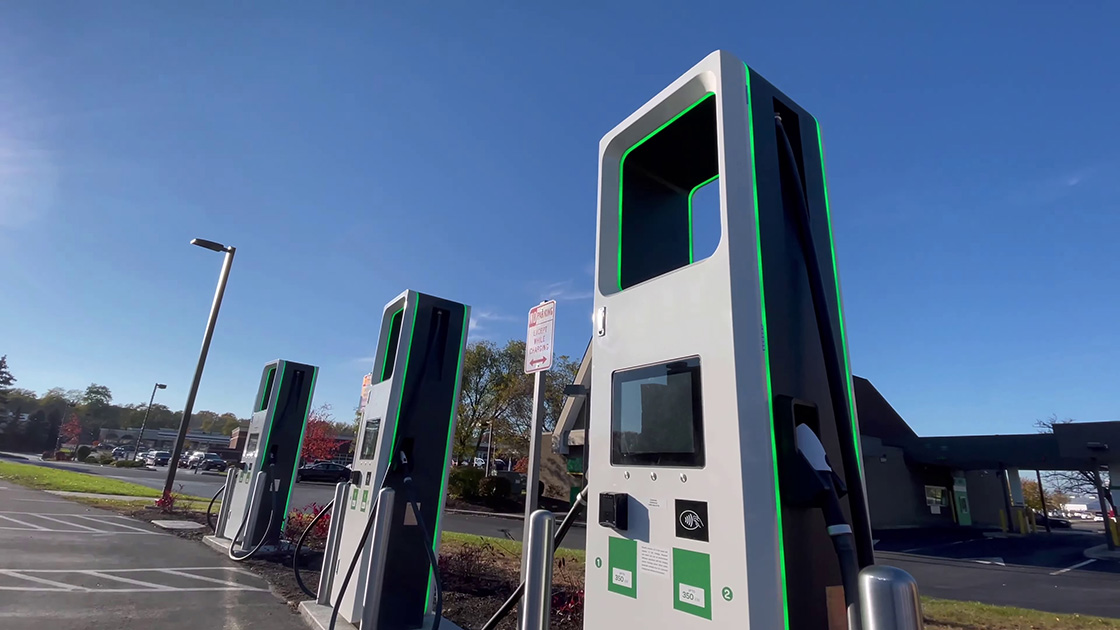
Federal funding will help states build new energy projects, including expanding electric vehicle charging infrastructure.
NCSL Staff Report | Dec. 5, 2022
Major federal investments are allowing state legislatures to pursue new energy policy goals and manage the impacts on consumers, workers and industry of the ongoing transition away from fossil fuels to low-carbon energy sources.
The federal Infrastructure Investment and Jobs Act of 2021 and Inflation Reduction Act of 2022 give states billions of dollars to help finance and build energy projects, including upgrading the electricity grid and expanding electric vehicle charging infrastructure. The new laws’ changes to federal energy policy have significant implications for states. Meanwhile, states are grappling with how to provide affordable, reliable, resilient and clean energy.
The federal infrastructure law and the Inflation Reduction Act create a multitude of new tax incentives, funding streams and programs to support transportation electrification, new and existing electricity generation, investments in electric grid infrastructure, and consumer home energy upgrades, among others. The new laws have the potential to unlock a massive transition toward a cleaner energy sector, including programs to support emerging technologies such as hydrogen and advanced nuclear power. In 2023, lawmakers will continue to explore how best to position their states to benefit from that new funding, including by identifying matching funds, creating or amending statutory authorities and overseeing executive branch implementation.
While most states have yet to implement new federal energy funds, a few have enacted laws to take advantage of funding for the Clean School Bus Program (Colorado SB 193) and the National Electric Vehicle Infrastructure Program (Arkansas SB 632) by creating sources of matching funds.
The infrastructure law also includes new federal support for the use of hydrogen in the energy system, and some states are already exploring ways to take advantage of this opportunity. Illinois (SB 2613) and Washington (SB 5910) enacted legislation to establish “hydrogen hubs,” and Arizona (SB 1396) and Nebraska (LB 1099) created hydrogen energy study committees. With numerous provisions in both new federal laws encouraging the development of nuclear energy, legislatures are likely to support existing and advanced reactors. California, for example, enacted a bill (SB 846) to continue operations at the Diablo Canyon nuclear power plant by accessing funds through the Civilian Nuclear Credit Program established by the infrastructure law.
A second trend for 2023 involves states addressing the sometimes competing priorities of providing clean, reliable, resilient and affordable energy. Some states recently adopted legislation establishing or amending policies aimed at increasing the capacity of renewable and other carbon-neutral technologies. During this period of transition, states are simultaneously working to ensure that the reliability, resilience and affordability of the energy system is not compromised, with several states signaling increased action on these issues. Overlap in these two broad initiatives can be seen in policies to develop transmission infrastructure; incentivize clean and dispatchable power (Maryland HB 31); bolster regional planning; address resource adequacy; and support microgrids and backup power (Colorado HB 1013 and New Jersey AB 336). In 2023, state legislatures will continue to manage these interrelated priorities.
For more information, contact Aaron Ray, the associate director of NCSL’s Energy Program.
Close article
Flooding in New Brunswick, N.J., after Hurricane Ida. Federal agencies are providing funds to protect communities and speed recovery from disasters.
NCSL Staff Report | Dec. 5, 2022
Over the past decade, the increasing frequency and intensity of severe weather have put state economies in peril as the costs of disaster recovery soar. With an eye toward protecting communities and speeding recovery, the Federal Emergency Management Agency, the Defense Department, the U.S. Forest Service and other agencies have bolstered funding to existing programs and established new funding mechanisms to meet state needs. Also on lawmakers’ radar: the reliability of water infrastructure and the environmental and public health threats posed by per- and polyfluoroalkyl chemicals, known as PFAS.
Many states have long been in a response and recovery posture when it comes to disasters, but increased costs and repeated extreme weather events have made this untenable. In 2021 alone, damages from natural disasters are estimated to exceed $280 billion. Current funding to support disaster mitigation is primarily managed at the federal level, with states applying to federal agencies to support mitigation projects. Through the STORM (Safeguarding Tomorrow Through Ongoing Risk Mitigation) Revolving Loan Fund, FEMA may provide funds to certain state agencies, which in turn can offer low-interest loans to pay for projects to protect against wildfires, earthquakes, flooding and other catastrophic events.
Modeled after the successful clean water state revolving fund, the STORM fund lets states prioritize projects for municipalities and support large projects to improve infrastructure resilience. The loan repayments will replenish the fund, allowing for ongoing investments. Over the coming months, states are likely to develop intended-use plans for the funds and pass authorizing legislation to create a framework to help them manage fund disbursement. This provides states with another tool to better protect their states from future disasters.
States are working with the federal government, localities and other stakeholders to ensure the future reliability and sustainability of their water infrastructure. Needs include providing safe drinking water, treating wastewater and managing stormwater. The Environmental Protection Agency recently estimated it will take more than $472 billion over 20 years to improve and maintain the nation’s drinking water infrastructure, the deteriorating state of which has attracted attention to lead levels and emerging contaminants.
Funding from the Infrastructure Investment and Jobs Act is bolstering state revolving loan funds, which can be used to tackle water infrastructure needs. States are already familiar with managing drinking water and clean water revolving funds and now have access to new programs and additional targeted appropriations. The infrastructure law invests more than $50 billion in water infrastructure programs, including over $20 billion for safe drinking water. Through the revolving funds, states can access $15 billion specifically for lead service line replacement and associated activities. Disadvantaged communities are also in a unique position to benefit from new grant programs and forgivable loans to fund drinking water projects.
While responding to this historic national investment in water infrastructure, states continue to explore policy options to streamline programs, conduct needs assessments and provide technical assistance. Legislatures are also leveraging funds to protect water supplies, fortify storage systems, expand water treatment facilities and prioritize the needs of small and disadvantaged communities.
Per- and polyfluoroalkyl substances, a large group of “forever chemicals” known as PFAS, are used in a wide range of products and are extremely persistent in the environment. They’re often found in soil and water near sites where they are manufactured, used or discarded. Given the associated public health impacts, state legislatures and the federal government are regulating the use of PFAS and cleaning up the environmental degradation that their production and use have caused.
In recent years, states have enacted legislation to restrict PFAS in firefighting foam; to regulate the presence of PFAS in drinking water, food packaging, textiles and consumer products; and to allocate funds for testing, cleanup and remediation. Some states have even banned the use of PFAS outright, with some exceptions for unavoidable circumstances.
Looking ahead, states are expected to continue to tackle PFAS through legislation, agency rulemaking and legal action. With $10 billion in funding from the infrastructure law dedicated to addressing PFAS and other contaminants, states are better positioned than ever to mitigate these pollutants in their drinking water.
For more information, contact Kim Tyrrell, the associate director of NCSL’s Environment Program.

With roughly 9 in 10 American adults using the internet, many consider access to be a necessity.
NCSL Staff Report | Dec. 5, 2022
As the internet pervades nearly every aspect of consumer life, state and federal lawmakers are addressing the growing interest in using digital currencies, the need for data privacy, and a fundamental reality: Broadband is not equally available to all Americans.
These issues will remain priorities in 2023 legislative sessions, though the effect on digital currency policies of the spectacular collapse in November of FTX, one of the largest cryptocurrency exchanges, is unknown.
Unlike paper bills and metal coins, digital and virtual currencies are not issued or backed by any government or any central bank. Rather, bitcoin and other digital currencies are used in electronic payment transactions—no coins, paper money or banks are involved. With zero or minimal fees, transactions are fast and unbound by geography and, similar to using cash, they are anonymous.
Like credit cards, tickets and other transactional items, digital currencies are stored in wallet apps installed by users on a computer or mobile device. Every wallet contains encrypted information, called public and private keys, used to send and receive digital currencies. All transactions are recorded in a virtual, publicly viewable ledger called the blockchain, which is maintained by digital currency “miners.” Anyone, anywhere in the world can be a miner, though it requires a willingness to invest in the specialized computer hardware needed to rapidly process complex computations. Miners are awarded digital currency, like bitcoin, ripple, dogecoin and litecoin, in exchange for verifying each transaction and adding it to the blockchain.
Thirty-seven states considered legislation regarding cryptocurrency, digital or virtual currencies, and other digital assets in the 2022 legislative session. Lawmakers are introducing and advancing bills that would let consumers use cryptocurrencies to pay state taxes; allow financial institutions or special-purpose institutions to hold consumers’ digital currencies; and regulate digital assets under the Uniform Commercial Code.
The internet and new technologies continually raise new questions about consumer privacy, and state lawmakers are addressing the array of policy issues arising from online activities. Legislatures have long been involved in regulating the privacy of certain information—Social Security numbers, student and medical records, etc.—and of specific industry sectors.
However, as an indication that privacy issues have grown in importance in legislatures recently, at least 35 states and the District of Columbia considered nearly 200 bills on the topic this year.
Comprehensive (aka omnibus) consumer privacy legislation was the most common type of bill considered—nearly 70 bills in at 25 least states and the District of Columbia. Comprehensive proposals generally regulate the collection, use and disclosure of personal information by businesses and specify consumer rights for collected data, such as the right to access, correct and delete personal information gathered by businesses. Five states—California, Colorado, Connecticut, Utah and Virginia—have enacted comprehensive consumer privacy laws.
Federal legislation, if enacted, may impact existing state laws and states’ ability to enforce privacy protections.
Other common privacy bills address the collection of data by commercial entities and online services; these include measures related to website privacy or children’s privacy on the internet, direct-to-consumer genetic testing, and internet service provider and information/data broker regulation, among others.
With roughly 9 in 10 American adults using the internet, many consider access to be a necessity. Because internet access is unavailable or inadequate in parts of the country, especially rural areas, state and federal lawmakers aim to deploy broadband—the technologies that allow internet data to be transmitted at high speeds—as universally as possible.
The Biden administration’s Internet for All Initiative, announced in May this year, puts $45 billion toward the goal of providing affordable, reliable, high-speed internet for all Americans by the end of the decade. The initiative will be administered by the Commerce Department’s National Telecommunications and Information Administration via three programs: Broadband Equity, Access and Deployment ($42.5 billion); Enabling Middle Mile Broadband Infrastructure ($1 billion); and State Digital Equity Act ($1.5 billion).
In the 2022 legislative session, at least 35 states, Washington, D.C., and Puerto Rico have pending or enacted legislation addressing broadband in a variety of policy areas: educational institutions, “dig-once” requirements, funding, governance authorities and commissions, infrastructure, municipal-run broadband networks, rural and underserved communities, smart communities, and taxes.
For more information, contact Heather Morton, director of NCSL’s Financial Services, Technology and Communications Program.

Increased oil and gas prices have helped economies in energy-dependent states initially hit hard by the pandemic.
NCSL Staff Report | Dec. 5, 2022
State fiscal situations continue to rebound as the COVID-19-induced recession subsides, though lingering inflation adds an element of uncertainty.
States faced steep revenue losses beginning in 2020 as consumers stayed home, some industries shuttered and many Americans lost their jobs. However, the ability of many employees to work from home helped shield states from some personal income tax losses. Consumers also proved willing to continue spending, particularly on home goods and other items that are subject to state sales taxes. Overall, revenues were sharply lower in fiscal year 2020 than states had projected, but the impact was less than many experts feared at the start of the pandemic.
As economies reopened, state revenues rebounded more quickly than anticipated in FY 2021 and have remained strong in FY 2022. Strong capital gains tax revenue bolstered some states, and increased oil and gas prices have helped economies in energy-dependent states initially hit hard by the pandemic. However, as states such as Alaska, New Mexico and Wyoming have noted, oil and gas revenues have been volatile recently, creating challenges and uncertainty.
Federal support has reduced the need for states to spend general funds in many areas. States including Alabama, Kansas, Nevada and Virginia also have used federal funds and surplus revenue collections for one-time projects to avoid creating a fiscal cliff if revenue growth slows and federal funds are depleted. Kansas, New Jersey and Virginia, for example, have used one-time revenues to fund retirement obligations or reduce other debt.
State revenue growth is expected to continue in FY 2023, but at a slower rate than in FY 2022. Many states expect personal income tax collections to be strong, though on average less than those in FY 2022 because, despite the high level of growth, states have also enacted permanent or temporary personal income tax cuts, reducing collections. General sales tax collections are projected to experience muted growth. Inflation is expected to increase sales tax collections, but real collections may be offset by inflationary spending pressures. Many states, including California, Colorado, Indiana, Montana, Texas and Washington, cite inflation as a challenge as they consider their upcoming budgets.
While overall state revenue growth is expected to be modest, state fiscal situations for FY 2023 are likely to be strong. Sensing that robust growth may not continue in future years, however, states are replenishing rainy day funds to mitigate the effects of a potential downturn. States have largely restored pandemic-related withdrawals, with several, including Idaho, Iowa, Kentucky, Maine, Mississippi, Nebraska and South Carolina, reporting healthy reserve balances.
Like private industries, governments are struggling to attract and retain talent, so while there is funding for many programs and initiatives, staffing shortages can create problems with implementation and delivery. Additionally, states have robust funds for capital improvements, but many are struggling with cost overruns and capacity to execute those projects.
Despite uncertainty caused by inflation, the war in Ukraine and other factors, states are hopeful the good times will continue, even as they prepare for slowing growth and potential challenges ahead.
For more information, contact NCSL’s Fiscal Affairs Program staff: Mandy Rafool, Erica MacKellar, Jackson Brainerd and Emily Maher.
Close article
At least 35 states and the District of Columbia have enacted more than 110 bills since 2020 to support mothers before, during and after delivery.
NCSL Staff Report | Dec. 5, 2022
Workforce shortages, overdoses, mental health disorders, maternal mortality—all are ongoing problems made worse over the last couple of years by the COVID-19 pandemic, and state legislatures are responding.
The nation has faced a shortage of health care professionals for years, with nursing being one of the hardest-hit professions. Nursing shortages brought on by an aging population, aging workforce, nurse burnout, long wait times for licensure approval and extended work hours not only strain health care systems but also affect patient care and overall outcomes. The shortages are particularly dire in rural and underserved areas, where lower salaries and intense workloads can impact retention.
Behavioral health conditions—including mental health and substance use disorders—are common in the United States. Nearly 1 in 5 American adults live with a mental illness, and 1 in 10 have had a drug misuse disorder. The pandemic has exacerbated the prevalence of these conditions, with reported increases in anxiety or depressive disorders, overdose deaths and suicide attempts. A shortage of behavioral health professionals, however, limits access to needed services, particularly in rural and underserved communities. About 37% of the U.S. population lives in an area with a shortage of psychologists, counselors and social workers, and nearly two-thirds of shortage areas are rural.
The demand for health care services is predicted to increase in the coming years due to an aging population and workforce as well as higher rates of chronic disease. The supply of providers, however, is not expected to keep pace with demand.
Data shows that the pandemic and other stresses may have triggered or exacerbated behavioral health conditions including depression, anxiety, severe mental illnesses and substance use disorders. At any time, about 1 in 5 adults and 1 in 6 young people ages 6-17 will report experiencing a mental health disorder. Mental health conditions not only can pose a significant burden to society but also can disproportionately affect specific populations, including youth and young adults, Hispanic people, Black people, essential workers, unpaid caregivers and rural communities.
In response, legislatures are strengthening and aligning health systems to support the behavioral health workforce, bolster behavioral health crisis response and increase supports for youth mental health.
A shortage of behavioral health professionals can limit access to necessary services, particularly for residents of rural and underserved communities. States’ policy options for recruiting and retaining behavioral health workers include understanding workforce needs, increasing the supply of professionals, expanding the reach of existing professionals, addressing the distribution of professionals and retaining the current workforce.
Several states have passed legislation to better understand the role of law enforcement in mental health crises and have taken steps to improve behavioral health care and treatment options for incarcerated individuals.
With the launch of the 988 Suicide & Crisis Lifeline, the 24/7 call number available to anyone in suicidal crisis or emotional distress, states are creating new options for preventing suicides and overdoses. In addition to establishing study commissions and task forces to evaluate the behavioral health care landscape in their states, policymakers are employing different funding and implementation models for the new lifeline.
Many states have enacted legislation to increase resources for youth mental health needs, address adverse childhood experiences and improve access to mental health treatment, especially in educational settings.
High—and rising—rates of preventable maternal mortality and pregnancy-related complications have caught the attention of state and federal policymakers, with many legislatures focusing on associated racial and geographic disparities. Recognizing the human, societal and financial costs of maternal mortality, at least 35 states and the District of Columbia have enacted more than 110 bills since 2020 to support mothers before, during and after delivery.
Lawmakers routinely pass bills or resolutions to call for action on maternal health, and many are commissioning studies to inform their policy work. All 50 states, the District of Columbia, Puerto Rico and several large municipalities have formed maternal mortality review committees to examine the underlying causes of deaths that occur during or within a year of pregnancy and to provide specific recommendations for reducing them. Responding to evolving needs, states recently have changed the membership, power and duties of their committees by, for example, including community representation or requiring recommendations to reduce racial disparities.
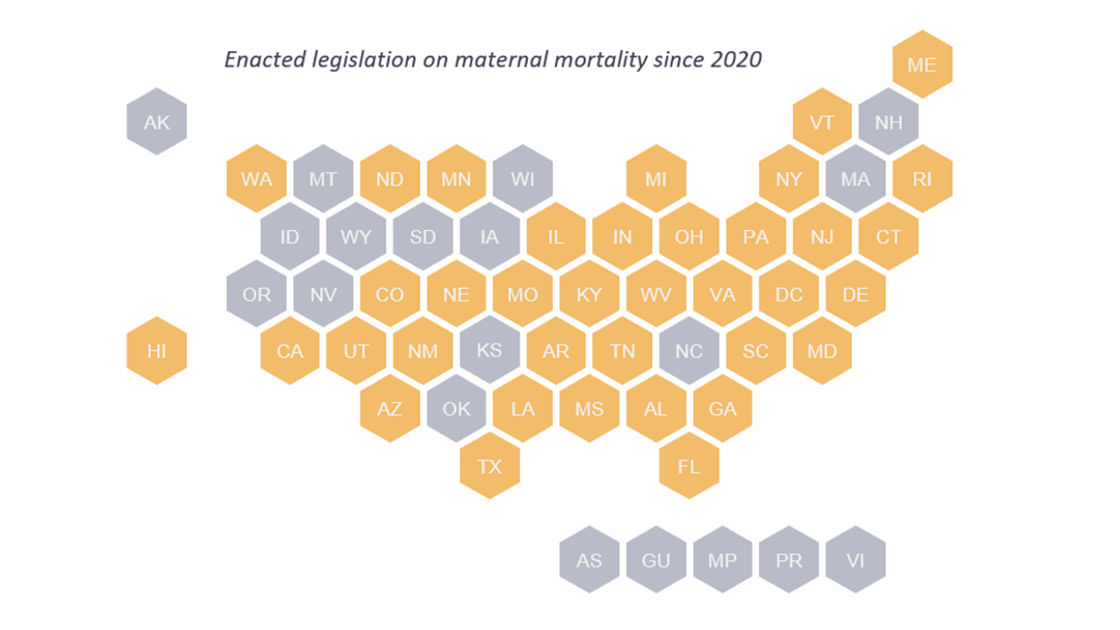
Some states expanded midwifery to address workforce shortages and to improve access to care for low-risk pregnancies in rural and underserved areas. Examples include licensing traditional midwives, expanding nurse-midwife scope of practice and requiring insurance coverage for midwifery care.
As the largest single payer of pregnancy-related services, Medicaid plays a significant role in maternity care. At least 10 states and Washington, D.C., approved doula Medicaid coverage; research shows that support from doulas is linked to better maternal health outcomes and decreased racial disparities. At least 24 states and Washington, D.C., have approved or are in the process of getting approval for the extension of Medicaid coverage beyond 60 days after birth, with the majority providing full coverage for a year.
For more information, contact Tahra Johnson, director of NCSL’s Health Program.

Lawmakers hope to reduce traffic crashes and fatalities, which are near all-time highs, particularly for pedestrians, bicyclists and motorcyclists.
NCSL Staff Report | Dec. 5, 2022
The enactment nearly a year ago of the $1.2 trillion Infrastructure Investment and Jobs Act ensures that states will receive hundreds of billions of dollars in federal transportation funding over the next five years. This unprecedented investment flows from the bill’s new transportation programs—for bridge replacement, passenger rail and electric vehicle charging—and from its support for existing road, transit and traffic safety programs.
In 2023, lawmakers will continue to debate how best to position their states to benefit from the new funding by identifying matching funds, creating or amending statutory authorities and overseeing executive branch implementation.
In the decade to come, states are likely to intensify their study of alternate transportation user fees and dedicate more general fund dollars to transportation projects.
Electric vehicles and other highly fuel-efficient vehicles are powerful tools to help states meet clean energy goals and reduce air pollution. But they can cause headaches for transportation agencies trying to maintain roadways. The reason: The vehicles use little or no gas, and the motor fuel tax makes up the largest share of state transportation revenue—38.4% in 2022, down from 41.1% in 2018, according to the National Association of State Budget Officers.
Forecasts indicate states will lose even more gas tax revenue as vehicles become more fuel efficient, with states predicted to lose as much as $87 billion in revenue by 2050 (see chart below). Despite high summertime gas prices and a few states adopting temporary gas tax holidays in 2022, states continue to act in response to declining revenue. Solutions proposed or enacted so far include road usage charges and per-kilowatt hour fees for public EV charging stations. Some states, including Idaho, Louisiana and North Carolina, have recently devoted more general fund revenues to transportation purposes.
To address declining revenues, Oregon, Utah and Virginia lawmakers all created voluntary road usage charging, or RUC, programs, an alternative to the gas tax that charges drivers based on their miles traveled. Virginia passed two RUC bills in 2022 (SB 237 and SB 612) that added privacy protections, ensuring that data from the state’s mileage choice program cannot be sold or distributed and requiring that program participants may opt out of location tracking. The Utah Legislature refined its RUC program in 2022, setting a cap on annual fees and making the usage charging rate 1 cent per mile until 2026.
Another strategy to address falling gas tax revenues is to charge users of public EV charging stations a per-kilowatt hour fee based on the energy they consume to charge their vehicles’ batteries. At least four states—Iowa, Kentucky, Oklahoma and Pennsylvania—have enacted such fees, with each allocating most of the revenue collected to transportation infrastructure projects such as road and bridge maintenance.
Washington enacted a major transportation package known as Move Ahead in 2022. The bill provides additional transportation revenue from the state’s carbon fee, an increase in fees for services such as issuing vehicle license plates, one-time general fund transfers, and the federal infrastructure law. Large investments in transit, bridge replacement and repairs, high-speed rail, active transportation and the state’s large ferry system are all part of the Move Ahead package.
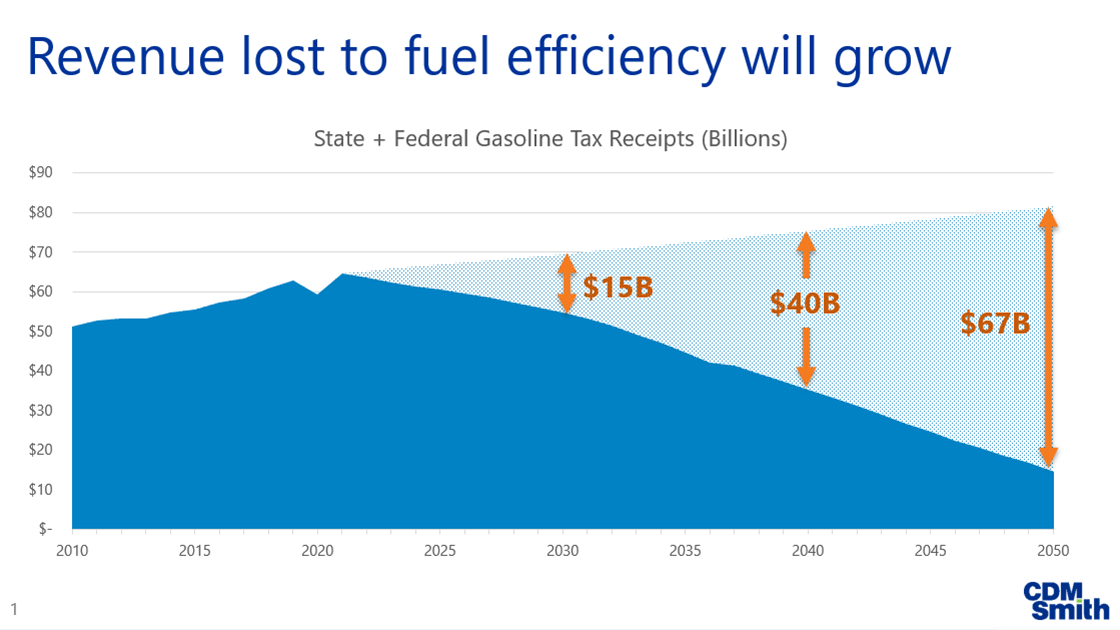
Traffic crashes and fatalities are near all-time highs, particularly for pedestrians, bicyclists, motorcyclists and other vulnerable road users. The upward trend accelerated during the pandemic, as nearly 39,000 people lost their lives on U.S. roadways in 2020 and an estimated 43,000 died in 2021. The problem is rooted in a combination of issues including excessive speeding, impaired driving and neglecting to wear seat belts—the three greatest factors in the recent increase in fatalities.
Ongoing traffic safety interventions include installing red-light and speed cameras and giving local governments more flexibility to lower speed limits. States are also toughening penalties for impaired driving while focusing on testing methods to combat polysubstance-impaired driving, a risky behavior that involves operating a vehicle after consuming a mix of drugs or drugs and alcohol. Meanwhile, lawmakers hope to curb distracted driving by raising fines and providing more transparency to existing laws to increase driver compliance. Currently, 48 states ban texting for all drivers and 24 prohibit all drivers from using hand-held mobile devices while driving.
Moving forward, lawmakers are likely to continue addressing road fatalities, as well as using programs created by the federal infrastructure law for financial and technical assistance.
For more information, contact NCSL’s Transportation Program: Douglas Shinkle, Annie Kitch or Mia Geoly.
Legislatures tackle a wide range of policy issues every session, but the focus shifts with the needs of their states and their constituents. This graph breaks down legislation introduced by topic since 2014, when NCSL began tracking.
Mouse over for details>>
Source: Compiled by NCSL staff using Quorum